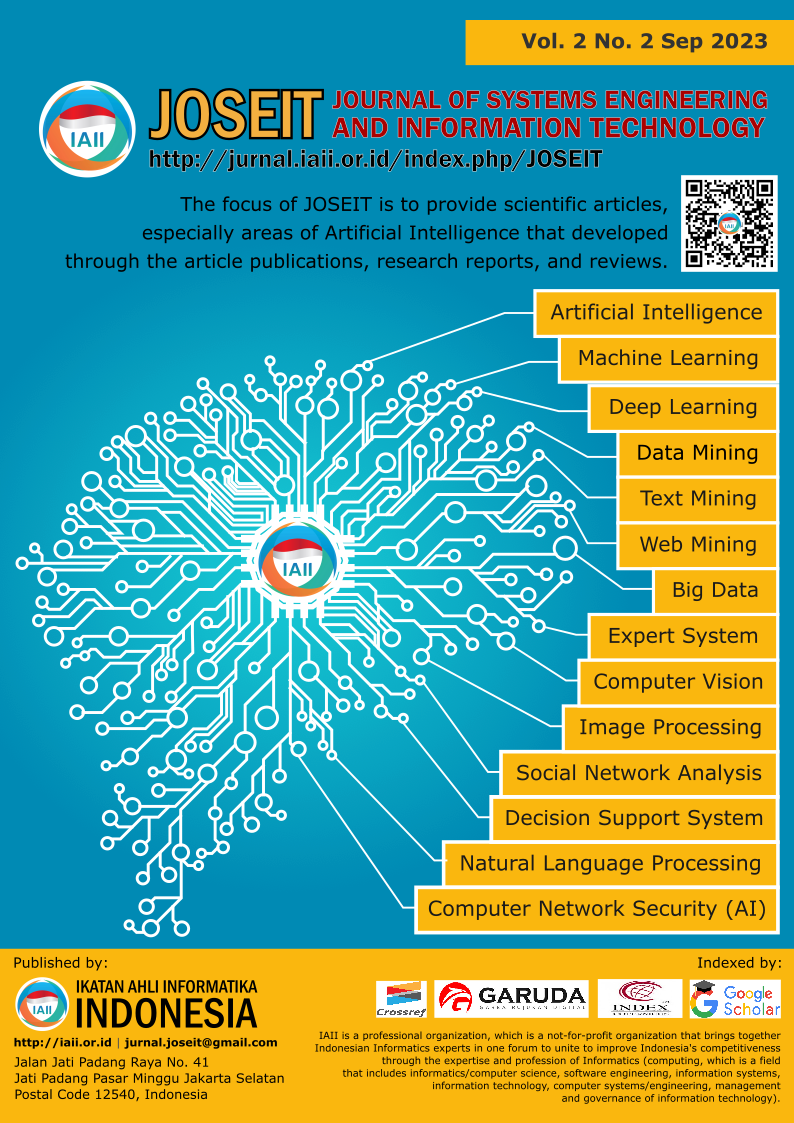Monitoring System for Temperature and Humidity Sensors in the Production Room Using Node-Red as the Backend and Grafana as the Frontend
Abstract
The client from the TRIAS project is facing issues with a decrease in production quality or defective products. They require a monitoring system for temperature and humidity in the production area, providing real-time notifications in case of any anomalies in temperature and humidity. However, the project has a limited budget, which poses a challenge for the contractor in developing a monitoring system that tracks temperature and humidity changes using temperature and humidity sensors as the data source. It should also provide alarms if the temperature and humidity values exceed the standard values for the room. Additionally, the pricing offer should be adjusted using information technology. The research methodology used in this study includes qualitative methods such as observation, literature review, and interviews to gather data on the mentioned issues. The SWOT method is used to analyze business process problems, while the Waterfall method is employed for system development. Based on the research findings, the researcher concludes that this project requires cost reduction in material usage and also needs a data visualization application for the mentioned sensors. The visualization application system utilizes Grafana as the frontend, chosen for its high flexibility in processing. The temperature and humidity data obtained from the sensors will be recorded by Node-Red as the backend and synchronized on the server. The data stored on the server will be saved in a MySQL database. The data from the database will be synchronized with Grafana for processing and visualization, presenting the data in easily understandable graphical forms.
Downloads
References
S. Susilawati, S. Suseno, and C. Rozikin, “Sistem Monitoring Suhu Dan Kelembaban Ruang Produksi Berbasis Wireless Sensor Network Pada Pt. Xxx Manufacturing Services Indonesia,” JUST IT J. Sist. Informasi, Teknol. Inf. dan Komput., vol. 10, no. 2, p. 136, 2020, doi: 10.24853/justit.10.2.136-143.
TRIAS Group, “Company Profile PT TRI AGUNG SINERGI,” https://trias-group.co.id/, 2018.
A. M. Bilal, “OBSERVABILITY OF INDUSTRIAL DATA USING AN ANALYTICS AND,” no. October, 2021.
Grafana Labs, “Grafana Labs. Dashboard overview.,” grafana.com. https://grafana.com/docs/grafana/latest/dashboards/
Grafana Labs, “Grafana Labs. Dashboard JSON model.,” grafana.com. https://grafana.com/docs/grafana/latest/dashboards/json-model/
Grafana Labs, “Grafana Labs, Visualization panels,” grafana.com. https://grafana.com/docs/grafana/latest/visualizations/
Grafana Labs, “Grafana Labs, Grafana alerts,” grafana.com. https://grafana.com/docs/grafana/latest/alerting/#alerting
R. Setiawan, W. Warsito, J. Junaidi, and S. W. Suciyati, “Monitoring Data Perubahan Suhu, CO dan CO2 Secara Real Time Menggunakan MySQL,” J. Energy, Mater. Instrum. Technol., vol. 1, no. 2, pp. 75–80, 2020, doi: 10.23960/jemit.v1i2.25.
S. Mulyono, M. Qomaruddin, and M. Anwar, “Penggunaan Node-RED pada Sistem Monitoring dan Kontrol Green House berbasis Protokol MQTT,” J. Transistor Elektro dan Inform. (TRANSISTOR EI, vol. 3, no. 1, pp. 31–44, 2018.
A. Mardan., Node.js Building real-world scalable web apps. Learn to Build complex web apps with Node.js.
“What is Express. Besant Technologies. what is Express.js.,” www.besanttechnologies.com. https://www.besanttechnologies.com/what-is-expressjs
E. H. Wiguna and A. Subari, “RANCANG BANGUN SISTEM MONITORING KETINGGIAN AIR DAN KELEMBABAN TANAH PADA PENYIRAM TANAMAN OTOMATIS DENGAN HMI (HUMAN MACHINE INTERFACE) BERBASIS RASPBERRY PI MENGGUNAKAN SOFTWARE NODE-RED,” Gema Teknol., vol. 19, no. 3, p. 1, Oct. 2017, doi: 10.14710/gt.v19i3.21878.
K. Thias Widagdo, I. Bayu, and Y. A. Susetyo, “Pemodelan Sistem Monitoring Sensor Curah Hujan Menggunakan Grafana,” Indones. J. Model. Comput., vol. 2, pp. 1–8, 2018.
S. Susilawati, S. Suseno, and C. Rozikin, “SISTEM MONITORING SUHU DAN KELEMBABAN RUANG PRODUKSI BERBASIS WIRELESS SENSOR NETWORK PADA PT. XXX MANUFACTURING SERVICES INDONESIA,” JUST IT J. Sist. Informasi, Teknol. Inf. dan Komput., vol. 10, no. 2, p. 136, Jun. 2020, doi: 10.24853/justit.10.2.136-143.
W. Nugraha, M. Syarif, and W. S. Dharmawan, “Penerapan Metode Sdlc Waterfall Dalam Sistem Informasi Inventori Barang Berbasis Desktop,” JUSIM (Jurnal Sist. Inf. Musirawas), vol. 3, no. 1, pp. 22–28, 2018, doi: 10.32767/jusim.v3i1.246.
K. Melkyanus Bili Umbu, “THERMISTOR SEBAGAI SENSOR SUHU,” J. Ilm. Din. Sains, 2015.
“Pengertian dan Fungsi Converter,” 2016. https://www.sebats.com/2016/08/pengertian-dan-fungsi-converter.html
D. Heryanto and Salma Azizah, “Application of Access Control List for Network Security At Cisco Router As a Firewall,” OISAA J. Indones. Emas, vol. 2, no. 2, pp. 71–76, 2019, doi: 10.52162/jie.2019.002.02.3.
D. Yuhendri, “Penggunaan PLC Sebagai Pengontrol Peralatan Building Automatis,” JET (Journal Electr. Technol., vol. 3, no. 3, pp. 121–127, 2018, [Online]. Available: https://jurnal.uisu.ac.id/index.php/jet/article/view/952
H. Haryanto and S. Hidayat, “Perancangan HMI (Human Machine Interface) Untuk Pengendalian Kecepatan Motor DC,” Setrum Sist. Kendali-Tenaga-elektronika-telekomunikasi-komputer, vol. 1, no. 2, p. 58, 2016, doi: 10.36055/setrum.v1i2.476.
M. J. F. Arifianto and L. Prasetyani, “Sistem Pemantauan dan Kontrol Energi Listrik Menggunakan Platform Node-RED, Influxdb dan Grafana melalui Jaringan WiFi dan Lora,” J. Fokus Elektroda Energi List. Telekomun. Komputer, Elektron. dan Kendali), vol. 7, no. 1, p. 61, 2022, doi: 10.33772/jfe.v7i1.23440.
Copyright (c) 2023 Journal of Systems Engineering and Information Technology (JOSEIT)

This work is licensed under a Creative Commons Attribution 4.0 International License.
Authors who publish with this journal agree to the following terms:
- Authors retain copyright and grant the journal right of first publication with the work simultaneously licensed under Creative Commons Attribution 4.0 International License that allows others to share the work with an acknowledgment of the work's authorship and initial publication in this journal.
- Authors are able to enter into separate, additional contractual arrangements for the non-exclusive distribution of the journal's published version of the work (e.g., post it to an institutional repository or publish it in a book), with an acknowledgment of its initial publication in this journal.
- Authors are permitted and encouraged to post their work online (e.g., in institutional repositories or on their website) prior to and during the submission process, as it can lead to productive exchanges, as well as earlier and greater citation of published work (Refer to The Effect of Open Access).











.png)




